Year 1 Wānanga 5
Te Oomai Reia Romiromi & Rongoā Report
Kia Ora Whānaunga
Thank you for the roles you all played in making this wānanga so very special at the Timi Kara marae. I trust that the mātauranga shared not only went into the cellular memory of your body but was also able to fill you kete until it was overflowing. Many thanks to all who helped in the kitchen to prepare and serve our kai to our tamariki, our kuikui and our Tohunga as well as help us with the clean up of the wharenui each day. Ngā mihi aroha ki a koutou katoa.
There are three marae in Moteo; Timi Kara, Moteo and Wharerangi, each of which are known for different kaupapa. If I remember rightly from the late Piri Prentice, and please correct me if I am wrong, the kaupapa of the Moteo marae is known for its mahi ‘wairua’, the Timi Kara marae is about ‘whānau’ and the Wharerangi marae is about ‘whakapapa’. Some years ago in 2011 I set up a facebook page called ‘Moteo Marae’ as it was so difficult for me to find any information for my assignments while studying with Te Wānanga o Raukawa. Both my parents kept us away from te ao Māori as they were Jehovah’s Witnesses that banned Māoritanga for us so as an adult, I had to research my whānau, hapu and iwi marae. To tell the truth, the whānau from the Moteo marae were not exactly forthcoming with information to help me complete my assignments for my bachelors degree. It was not until I attended a wānanga at Moteo wth Pat Parsons years ago that the whānau understood my being estranged from my marae. The facebook page was to support other up and coming whānau who were going through similar struggles with their whānau, hapu and iwi research. My Mum and Aunties supported my quest with whakapapa as they were experts in whakapapa as my great grandmother Heni (Jane) Greening (nee Mitchell) was sister to Jack Mitchell (author of the book Takitimu) and (Hera) Sarah Tareha (nee Mitchell) all of whom were from a long line of Tohunga.
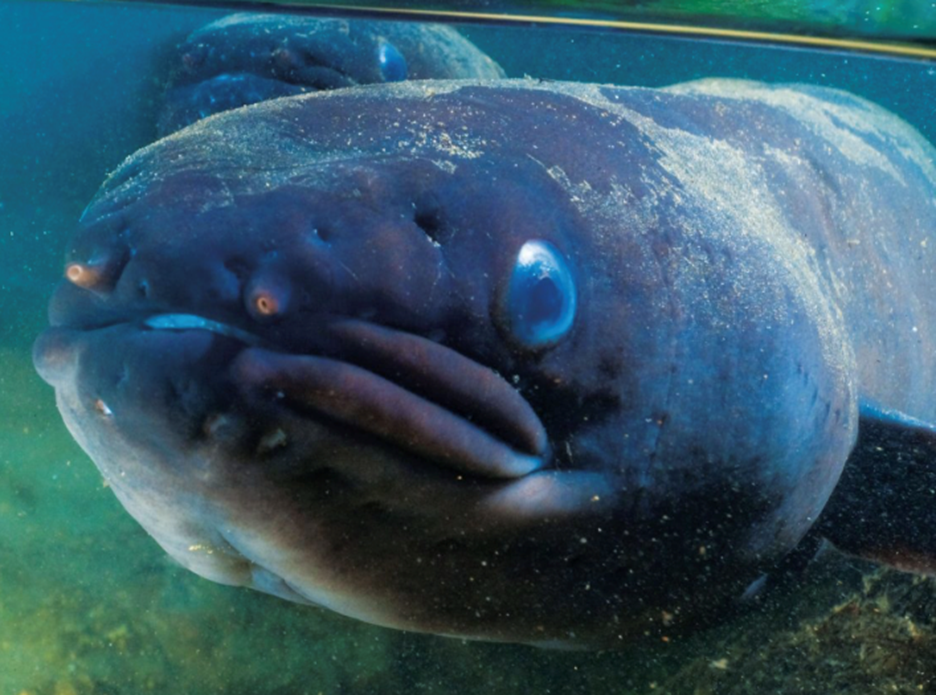
Our taniwha from Moteo was seen by a number of you at the Timi Kara marae. She even followed Robbie and John, our Tohunga Rongoā, all the way home. There are two names she is known as, Hinewera and Karukaru. Whanau from Omahu identify her as a female with red hair. As a taniwha, she is a kaitiaki (guardian) who looks after the Tutaekuri river. Many of our whānau describe as having one or two big eyes called Karukaru. Another experience by Karl Teariki as a kid eeling one night, identifies Karukaru as a log sized tuna at the bottom of the deep calm hole across from the Ōhiti pā, below Pōhatunui. He described a big rock with a cave underneath it, the entrance about 6 or 7 feet underwater and about a metre and a half across. He thought it was a log that looked like an eel that was lying on the bottom of that pool about 9 or 10 feet down, but on their way back, the log was gone. When he told his Uncle what he saw, he said that the same tuna used to watch them swimming when they were kids. The taniwha are very old, timeless and ageless in wisdom. Hinewera is known to pop her head out of the cave, and just sit there at the bottom watching them playing. Ko Karukaru tērā. Perhaps she was watching us playing too.
Our Saturday morning started with our mihimihi and it was so beautiful to have all our tamariki with us seated in the front and some engaging in doing their pepeha. Lovely to see our rangatahi supporting our tamariki throughout the wānanga and the tamariki taking turns with the pepi.

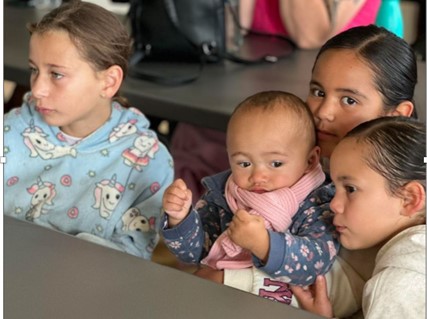
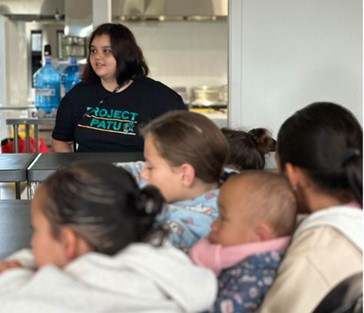
It was such a blessing to have our Tohunga Rongoā Robbie Richardson and John Te Amo with us. It is always such a pleasure to be with them and am so grateful for the magic they share with us all. Please scroll down to see all the feedback and reflections of our whakawātea and Rongoā sessions.
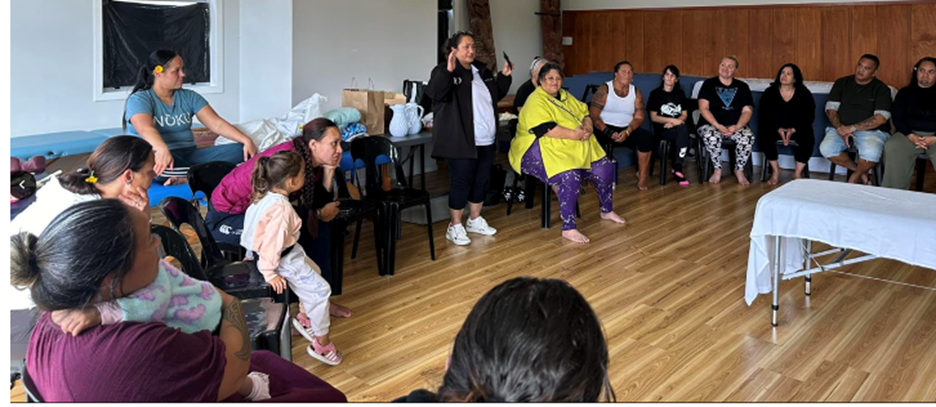
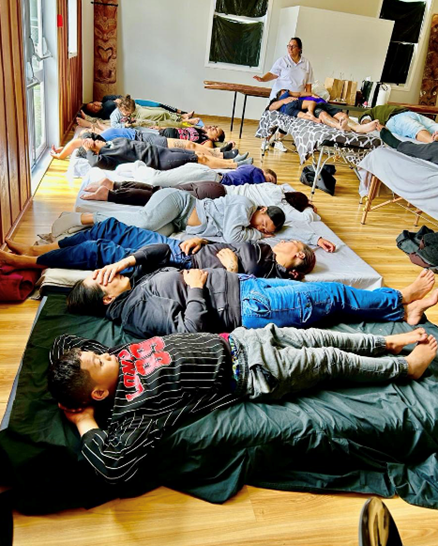
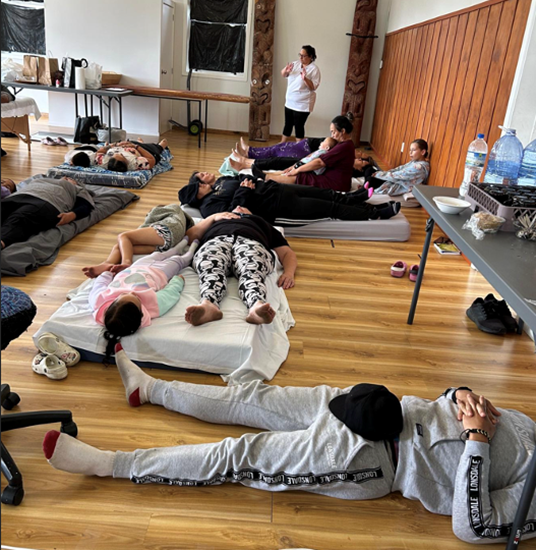
For those of you who asked, the music for the whakawātea was by the renowned taonga puroro practitioner Jerome Kavanagh, a nephew of Robbie’s, who especially composed the music used for the whakawātea sessions.
A feature of this wānanga was with a whaiora with cancer whom Charlotte was working with as an ACC misadventure case of misconduct by one of the Drs from Te Whatu Ora. Very grateful to Choc, his wife and their bubs, for coming to be an example so our tauira could learn how to heal this mauiui. It is timely to demystify our healing ways so that our tamariki can learn at an early age and thererfore have it for life. When they are older they too will be the kaitiaki of this mātauranga and pass down the healing lores of our ancestors to their mokopuna, just as it has been passed down to us throughout the generations. Our Tohunga were able to use a whole range of ancestral healing philosophies, rituals and rongoā practices to show our tauira the different ways that we heal cancer naturally without MEDS.
Charlotte gave a debrief first with how our local rongoā practitioners were working with the whole whānau not just the whaiora, to show them how to support Dad with the kawakawa poultcing that draws out the chemotherapy drugs in his system. The colours of the leaves reveals which organs are affected by the cancer. The changes in the diet works to support the healing of the body as sugar feeds the cancer and drinking water keeps the body alkaline. Disease cannot survive in an alkaline body. On the other hand, a diet with no water, coffee and sugar foods will make the body acidic. Disease will thrive in an acidic body, more especially with cancer. Alternative naturopaths use a strong concentrated THC cannbis oil to kill the cancer and CBD oils can support the emotional and neurological states of the brain while trying to cope with the stresses of the disease.
Robbie and John went over the rongoā supplements and pani they had made for Choc to further support his recovery. The pani had to be applied to the skin before the leaves. Our healing team took this opportunity to show the tauira how to poultice.
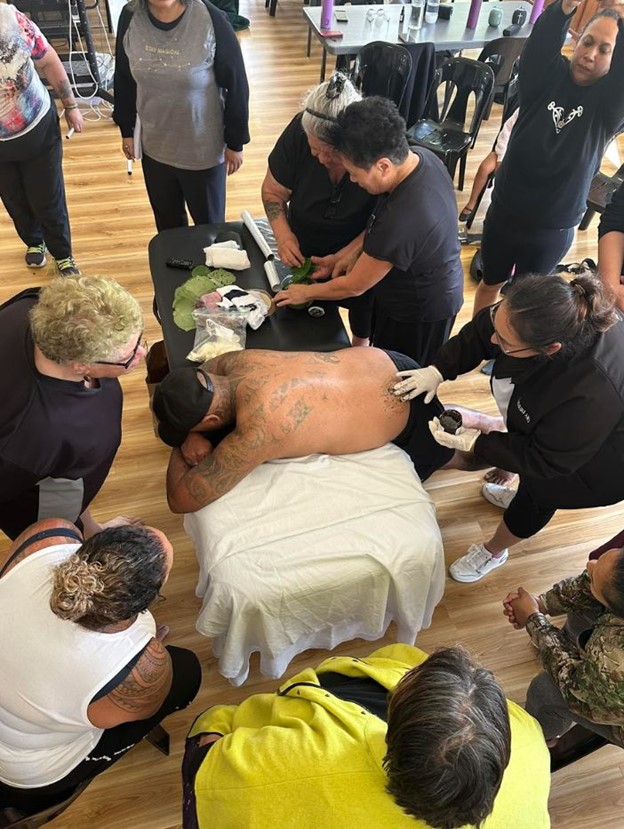
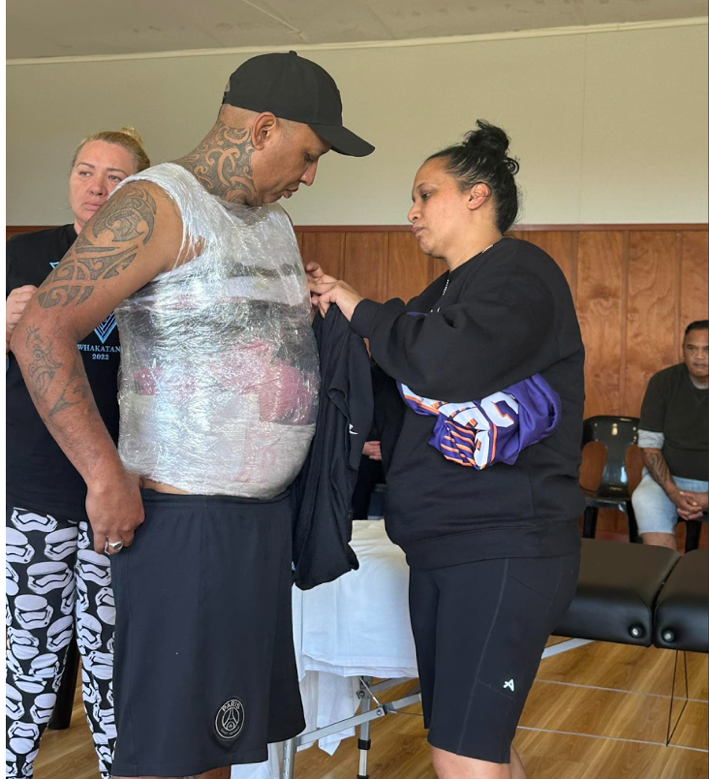
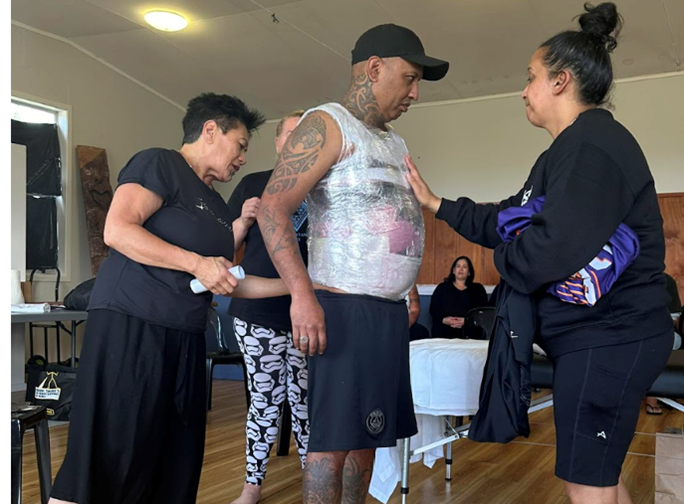
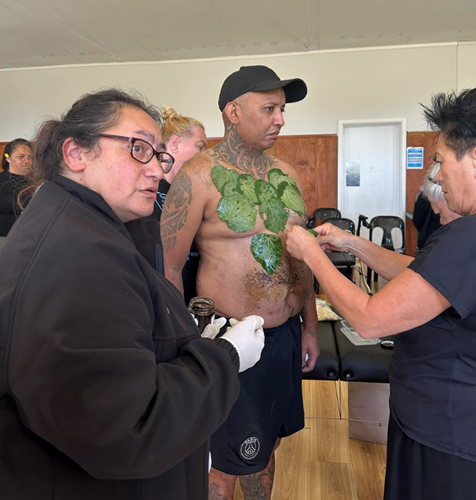
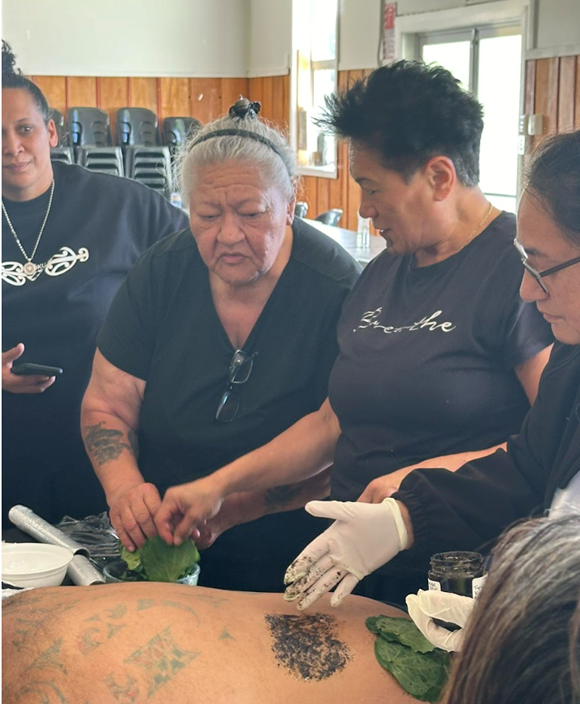

As per ususal, more whānau came on Sunday in support of the wānanga and so we just kept moving around the chairs to fit every body in.
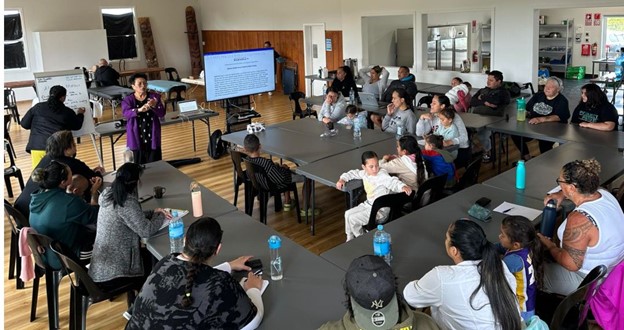
The bum shuffling is a means of keeping the hips soft and supple for romiromi. This bum shuffling race was a hoot and there were lots of squeals of laughter that filled the whare! Laughter is so healing for the soul.
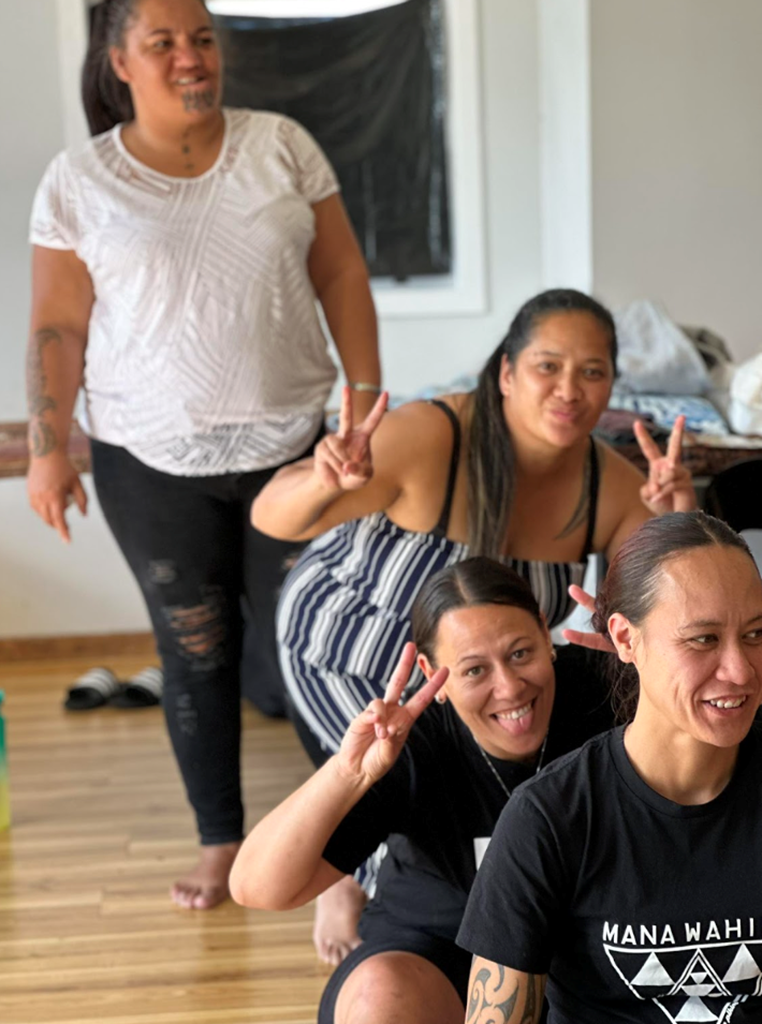
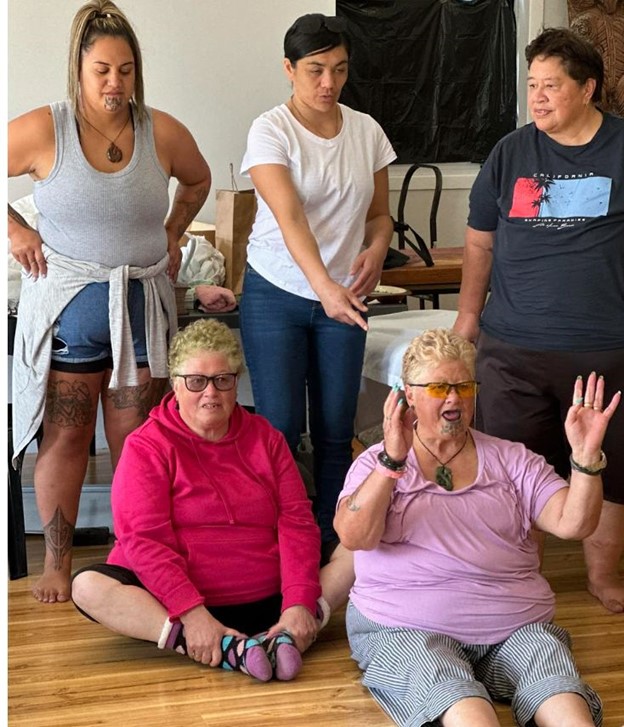
Another exercise with Charlotte was to come together in a state of ngaitahi as taught to her by Papa De La Mere where the power source (the feet) all link together with one another so as to have full power. Using the takutaku to shift and change the energies as a collective, is is another way to whakawātea to lift any unwanted energies all at the same time, using a vortex. The tamariki were right in there with us as well.
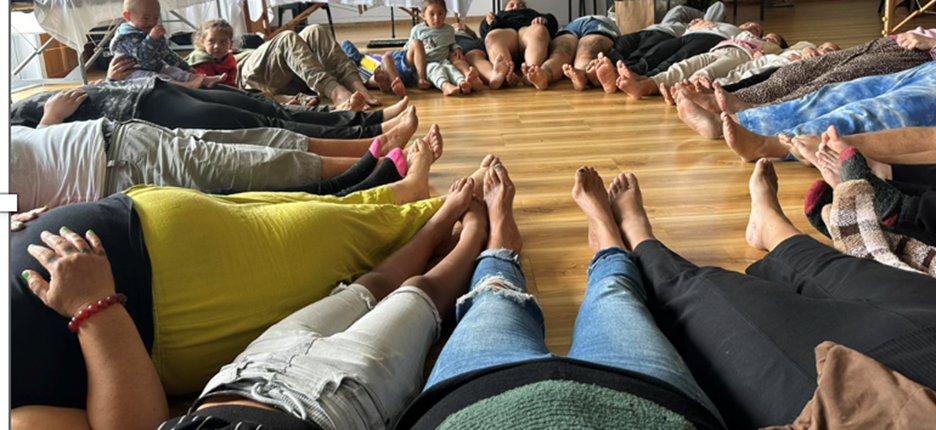
Our fuzzies continued to practice this outside on Papatūānuku with some of the tamariki.
Our kuikui from Waiohiki came on both days. We will always provide mirimiri for our kuia as our taonga.
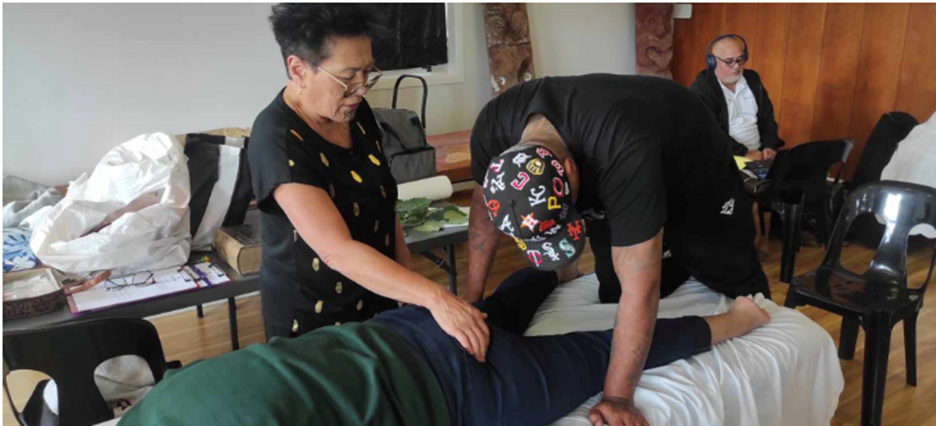
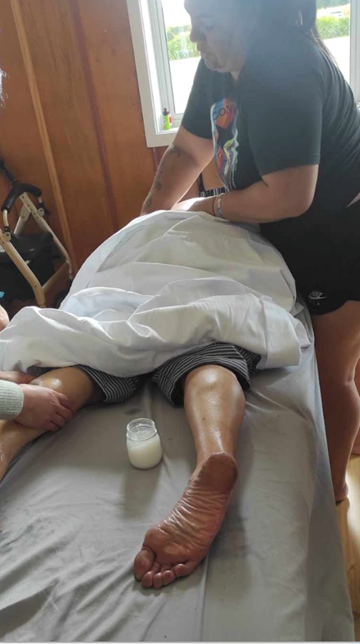
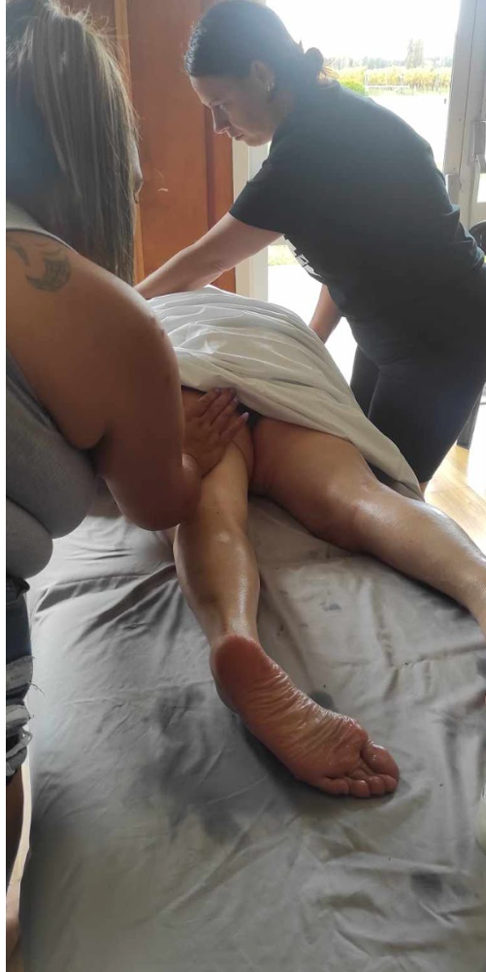
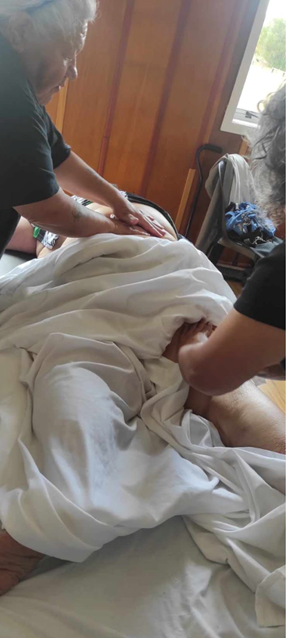
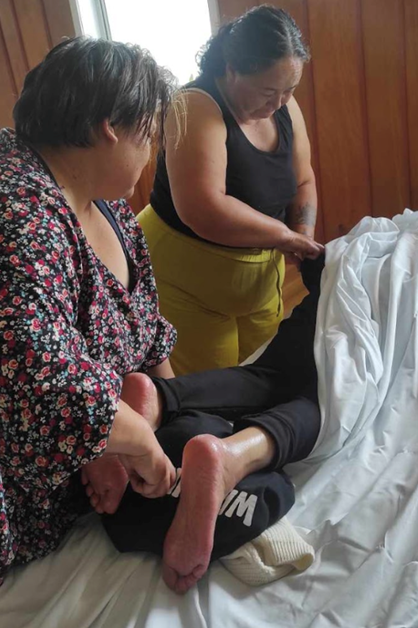
TAUIRA REFLECTIONS
Here are some of the reflections from some of our tauira that you will no doubt find interesting e te whanau. As you know to kick off our wananga, we start with a mihimihi, sharing who you are, where you come from and what you hope to achieve here at the wānanga. Although we had some magical reflections, we could not fit them all up here but they will go towards the report to Te Aka Whaiora. There are a few choice ones here for you but those you haven’t heard from yet, all of which are awesome learning opportunities where we learn the most as Māori from pūrākau.
Evaluation for Miri: I came here to learn a bit more so I can play my part in passing down the knowledge to the next generation, my whanau.It resonated for me when Robbie and John talked about having our own teams and getting to know who they are and how to communicate with them. The discussion on letting the walls down was a timely reminder to recognise when the walls are up and to let them down. The week before the wananga I had a dream where I got told to connect into my whatumanawa and connect with plants to kind of read them. I went to connect with my hands but got scoffed at and the lady whacked my hand away and told that I needed to learn how to connect with the plants without always having to touch them. Hearing John talk about the communication with his team and the plants reminded me of this dream. His gift is amazing, and I felt gratitude for his sharing and for Robbie elaborating on his kōrero after. I found it really inspiring.
I felt blessed to watch the mahi with the misdiagnosed man and his whanau. It felt really good that his path had led him to Charlotte to help guide his healing. I felt in awe of her ability to help so many people and train us at the same time and do a million other things too. It stirs me up when I hear of injustices for our people and constitutional oppression. Charlotte feels like a lighthouse in the dark, you still have to make your own way there, but you have a bit of guidance and support in the direction to go.
When the whakawātea began I smelt an outside campfire. I felt a bit unsettled in myself, frazzled by the week I had. I focused on my breath, just being, and being ok with feeling fidgety and letting go of any expectations. I loved the lull of the sounds and hearing the Karakia in the background. Different parts of me sort of niggled towards the end, just before Robbie said we might feel that. Afterwards, I felt at peace. I feel like I’ve learnt so much, have so much more to learn. I keep going over the other wananga in my head and on the app trying to learn more from them. The more I learn in the present the more I can learn from the past, so I keep going back. My daily life experiences feel so much more enriched and I’m more aware of the Tohu and things around me. I feel more engaged.
Evaluation for Alex: I attended my first wānanga at the end of last year, I’ve never looked back since. It was life changing, empowering, and I am just fully committed to this kaupapa and our whānau. What I hope to achieve is to add to my basket of knowledge and strengthen my connection to strengthen connections to our whānau. Kia ora.I have come all the way here from poroporo, it’s just outside Whakatane basically to learn more about where we’re from. I’ve learnt a lot and I hope to keep learning. Basically, just rolling with it and loving the experience to grow my knowledge base. I aspire to provide whānau with a safe space to be in to be able to heal and to help our whānau through life, really. Yeah, it’s awesome to be amongst you again.
So my objective of today, was to come and grow my knowledge base. To help towards my goals and aspirations, to provide my whānau safe spaces to explore themselves, heal themselves, and get to know themselves better. I think I have done that. I’ve learned quite a bit today. Kia Ora to whaea Robbie and matua John, ka pai. And, also, I love being here with you peeps. I always tend to get a bit whakamā when doing group activities, connecting within our whatumanawa, as I feel like sometimes I am not enough, I can’t do it. I question myself whether I could even control it if I was to succeed in connecting etc. Then up go my barriers. The awesome way whaea Robbie broke it all down helped me in so many ways, especially with my confidence in how I absorbed mātauranga more effectively. Paired with hers and Matua Johns whakawātea, it blew my mind. It left me in a totally revitalised state, I felt more in touch with my wairua side. Also matua John’s vast knowledge of Rongoā was just outstanding. Their level of mātauranga is beyond amazing and I am so blessed with having this opportunity to be able to work alongside you aunty Charlotte and being given access to the wonderful tohunga and tohuna that surround you. Aroha mauroa xo
Evaluation for Tarnz: I wanted to achieve more learning and just more growing. Help myself, my healing process, my whānau journey of healing, and for everyone around us. Yeah, making those connections, building up on our connections. During wānanga we had the privilege to learn alongside an amazing couple, Whaea Robbie and Matua John. They work as individuals and united in their own specialized areas of mahi. Whaea Robbie’s kōrero around the importance of connecting with our team resonated with me as I’m constantly working from the mind. I struggle to ask for help or to accept any help. Being reminded that I have my team of kaitiaki with me and being taught how to connect with them, how to be specific in my asking and making sure I am opening myself up to receiving from them, gives me a sense of peace and calm during my daily stresses. We have our kaitiaki waiting for us to receive so we need to be removing our barriers and connect with them.
During the whakawātea, I felt relaxed and in tune. I could feel the clearing throughout the 13 realms. After coming back to our current state, we went outside to connect to Papatūānuku and Ranginui. As I lay on Papatūānuku, ha ki roto, ha ki waho, I opened myself up to receiving energy from her. I was cleansed of the energy’s no longer serving me and refreshed with new, divine energy that is needed for me. My mind was clear, which never happens, and I felt peaceful.
Matua John shared his connection with ngā rākau and how he uses this to create specific rongoā for whaiora. The way he delivered his kōrero was captivating. For someone so reserved and quiet, I could feel his kōrero being driven by what was needed in the whare at the time. Hearing about the struggles the whaiora has been through and witnessing the changes within hours of Matua John and Whaea Robbie’s mahi, was validating. This is the mahi, we as Māori, need to be able to heal and move forward from generational trauma.
Thank you Whaea Charlotte for the mahi you continuously provide for us and organizing Whaea Robbie and Matua John to share their mahi. Your teachings are life changing experiences and I love how you always provide the tools we need to continue this mahi within our own whānau. You have this unique way of sharing your knowledge and it really resonates with everyone. We’re so grateful for all of your time and expertise.
Evaluation for Sydney: Here to just keep filling up my kite, healing myself, so we can help our children heal themselves, just keep passing it on.Loved the mahi shared from the amazing Whaea Robbie and Matua John. Thoroughly enjoy being in their space, our whakawātea was perfect! Laying down next to my daughter, while we both drifted off and next to me close by was cuzzy Lisa. I was able to drift off with a quiet mind at peace. Have been practicing being in my whatumanawa in my own time and since wānanga 5 and I have been connecting with my team every day since. Grateful for that knowledge and to continue ensuring that my whānau are practicing also. Having our children there present with us is an amazing experience for them and I am so happy and grateful they r able to be present at such an early age.
Whaea Charlotte, the knowledge you bring every wānanga is amazing!! When we go over what we have learnt from previous wānanga, it helps to retain the information as well as having the app to be able to go back and revise. Grateful for your continuous knowledge you bring to every wānanga.
Evaluation for Krystal: I want to achieve more learning, and growing, making connections, and healing myself, my whānau, my community. Reflecting back on wānanga 5, the weekend for me was enlightening, fulfilling & healing. Whaea Robbie & Matua John’s kōrero was fascinating they speak with such passion I was hooked on their every word. I learned that asking questions helps to break down my barriers to connect with my team, I was able to smash them down eventually. During the whakawātea, I struggled to quiet my thoughts at first, but afterwards, my mind was clear, quiet & at peace, something I haven’t had for a very, very long time, I felt relaxed & all the things I was stressing about beforehand were gone. I’ve been practicing because I wish to maintain those feelings outside of the wā. I also found after a lot of the kōrero that I was more at ease with myself & what I have been experiencing for a lot of my life was validated. Before the wānanga I had so many questions & they were answered by different people over the weekend. I shared some of my experiences with others & felt comfortable doing so. The space at the wānanga makes me feel safe to be able to talk about things without the fear of being judged, everyone embraces everyone. I got to see & learn the benefits & different ways to do a poultice, I saw up close how to do it properly & learned that you can also apply rongoā before putting on the kawakawa leaves. Whaea Charlotte’s teachings & support during the wānanga is invaluable the mātauranga that she shares is uplifting and continues to inspire me & her team just as much so. During the process of learning romiromi I felt comfortable asking questions throughout to help me to do better and gain more confidence. I have so far attended 2 wānanga but each time have left with so much to add to my kete, more understanding of mahi a wairua, romiromi, rongoā etc. I’m so grateful for every bit of the experience throughout its non-stop healing & such a great feeling being amongst like-minded people and not so alone. I left feeling balanced & calm. Ngā mihi nui Whaea Robbie, Matua John, Whaea Charlotte & the team.
Evaluation for Raewyn: I’ve been on this journey for a couple of years now, wānanga. You don’t look back, it’s always forward. Always learning something that you can take home and put on yourself to try to better yourself, to help you whānau, and my hapu and your hapu too. When we started the whakawātea I felt nervous, I could feel my heart beating fast. Not too long I felt relaxed and at peace as I breathed through it listening to the different sounds. During the session I could feel my left hand shake a bit and left leg then my right wrist, both knees held pain too, it felt like something was pulling a rod or something out of my top right thigh and hip. My left foot got sore. After the session I didn’t have any thoughts in my head it was clear, I was trying to think of something as usually my head is full of chatter, but it was good that I didn’t need to think.
All the way through Robbie’s kōrero I was holding back the tears then when John’s kōrero came, again I felt very emotional, trying hard to stay neutral, as everything they spoke about was close to the heart, their manaaki, tautoko makes me just tear up thinking about it. The endless love they have for everyone, the same as Charlotte, they are warriors of truth. Then when it was lunch, I went to the wharepaku and stayed there for a while, having a tangi, letting it flow then when we went out the front, taking in Hinenuitera, I knew what it was that I must do.
Evaluation for Judy: What brought me here was a journey of trauma I identified in our whakapapa, and I am here today to break that cycle of trauma within my whānau. So, it’s been a learning journey, a healing journey, and that is why I’ve come today’s kaupapa and want to thank every one of you that tautoko me with our old people and I have not been exposed to that before until I met Charlotte. So, thank you for allowing us to be in your presence, Ngāti Kahungunu, you have a basket of a wealth of knowledge here and it has brought me out of my comfort zone, and I hope to take away so much to help my whānau who have gone through experiences and continue to carry experiences, and through my engagement, no doubt with every single one of you will imprint on my whānau. I have nothing but much appreciation. It has been a journey just to get here. First time my nephew has been a part of a kura. He doesn’t go to kura. This was his first classroom. And he was very tentative. And, if you know our story, he has four clinical diagnosis. This experience in the kōrero that I hear, I go away hopeful. I feel like he is pumped with toxins and when I hear about the Rongoā that helped your Papa and our tane over here, I become hopeful for my nephew. He helped me on this journey to look at kaupapa Māori wānanga Rongoā. These are tears of kind of gratitude, more than anything. Aroha mai. Because he’s only nine years old. And I worry for when he becomes an adult that all of that hara, that follows with those toxins and that’s why I cry, because “Oh, yes!” Many thank yous for allowing us into your space, to share your space. Because I heard your whakaaro about trauma and healing. I believe that after today, that I’ve been a scientist in my own way…does that work for us, or don’t go there. For me as a mum, I have the love for this child, but I don’t know the answers on my own. I’ve had to fight DHB, Oranga Tamariki, and that can be a journey on its own. And not many of my whānau are strong enough to do what I do, but I do it for the love and aroha for this little baby. I would do the same for him as I would for my own. Not only has today been a tohu, my engagement with Charlotte, and the tokenism of gratitude that I want to show and thank you every single one of you whānau. And usually, I am very confident when I bring it up to people but when it comes from a good place.
It is very hard to kind of reach for that help and understanding. Having the chance, I could bring my babies. I don’t go anywhere without my babies. It is hard lesson for me to be able come to a kaupapa that allows that. It means everything to me. It comes with a lot of respect. I really appreciate that whānau because you go into a kura or a university, you can’t take your babies, you’ve got to book them into a day-care. I am very grateful to see him engaged. Yes, he gets up to no good, but if I can offer an alternative as an Auntie, as well as heal my own internal whānau hara. If I can take in any sort of resources, I have been, since my introduction to Charlotte, and I know that this is only one more opportunity and I don’t regret it at all. I am very selective of who and where I spend my time because of my babies. My other little boy is four years old with autism. So, even though I want them to engage, even if it is a snippet…it is their whānau gathering as a wānanga Rongoā, romiromi, te mauri Aio experience. Although I have had my own personal special encounters, as a whānau, this is our first. To all of you and whaea Charlotte, thank you very much from the bottom of my heart. I hope that having us around, that at any stage in life, when we have whānau that are medicated that we might become inspired to make Rongoā and that’s where I am at because romiromi has impacted on my whānau’s life personally. And that is why I have chosen this pathway as natural healing. I don’t smoke, yes, I’ve had the waipiro. I’ve done the naughty things in my previous life, but now I just want to look after and nurture our babies. And that’s where breaking the cycles is where I know I need to ensure that this happens in my whānau. Kia ora, aroha mai. Thank you very much.
Evaluation for Tahu: I just want to thank brother Choc for allowing to be whaiora today so we could learn from him and learn from our Tohunga who are with us. The importance of our small village is being able to help each other. Like our nannies here, you can’t do this by yourself. You need your whānau to support you in your wellbeing. Yep, couple of weeks ago I got pneumonia. I got my ass kicked and my ears slapped and they’re still painted on. Our Rongoā is magic. I’ve been on bloody pills for years. I hate it. I hate the diabetes pills. I don’t take them because it just doesn’t agree with my tinana. I choose our Rongoā. Last week I went to a [kidney specialist] and I told him I was taking our Rongoā, and he says, “How is that going?”. I said I don’t take my pills, I am on this, this, this and this and the only thing I might take is the TRULICITY to help with my diabetes because I only must take one jab a week. But there is not that much TRULICITY in the country. So, I’ve been taking our Rongoā Māori, and I’ve been coming along to wānanga to learn about how to heal tinana, because I don’t want to be on drugs. I’ve watched too many of my whānau be on those drugs for years, and years, and years and never get better. He goes, “How’s that for you?”. Well, I’m here. I’m here today, I wasn’t walking a couple of days ago. He says, “Continue on with your Rongoā. What else have you been doing?” I said, “Learning about the wairua.” He says, “Oh, that must be amazing.” That was really cool, it was the first doctor who said to, “carry on doing what you do and take what you need. There might be a balance that we have to do. You have some of your Rongoā and some of my Rongoā.” Yep, I can do that. That’s the first doctor that has said that to me, ever. He didn’t even discredit using our Rongoā, not once. That’s amazing! That’s why I’m here to learn and that’s why I bring my babies along. I drag them here because they have gifts too. Sometimes we abuse ourselves because of the colonisation, the Western system. So, thank you for allowing us to come along and participate in that part of the mahi that we are learning today.
Wananga 5 Notes
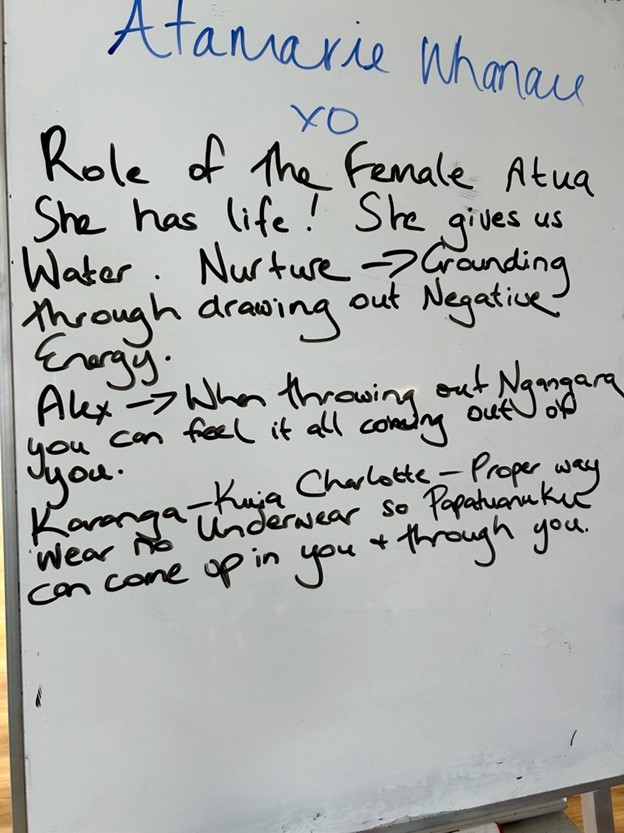
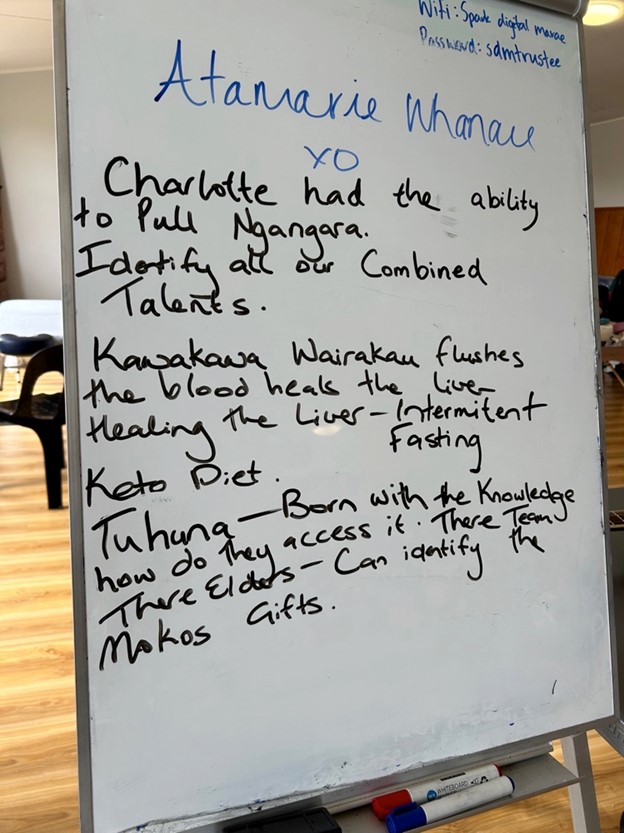
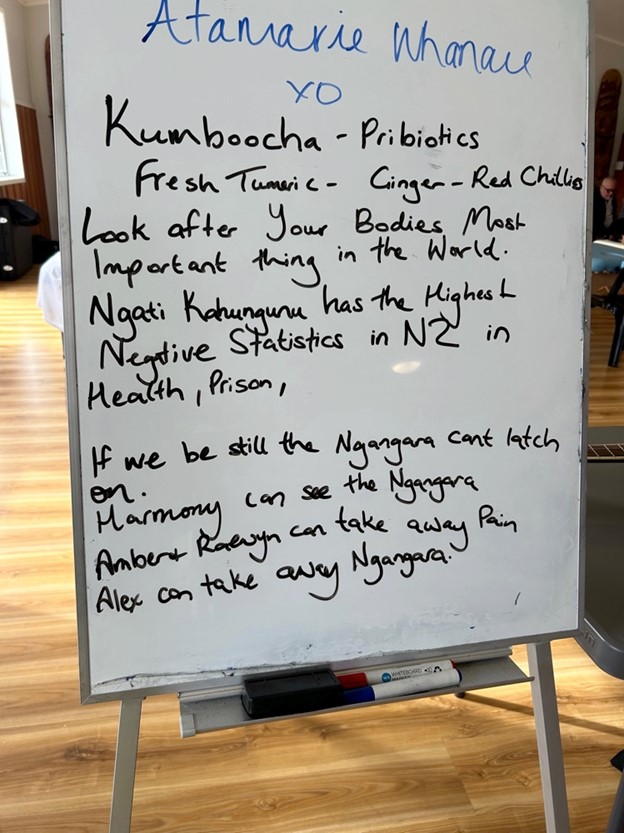
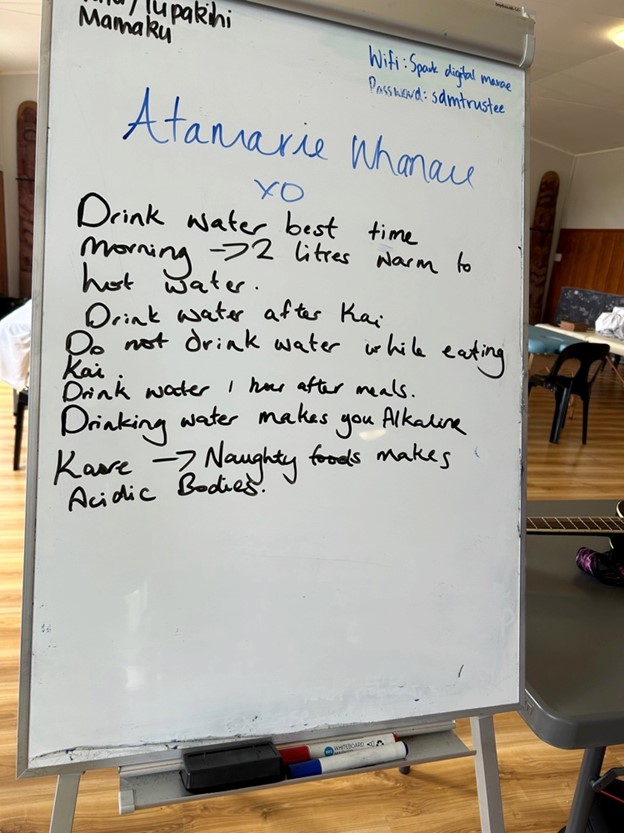
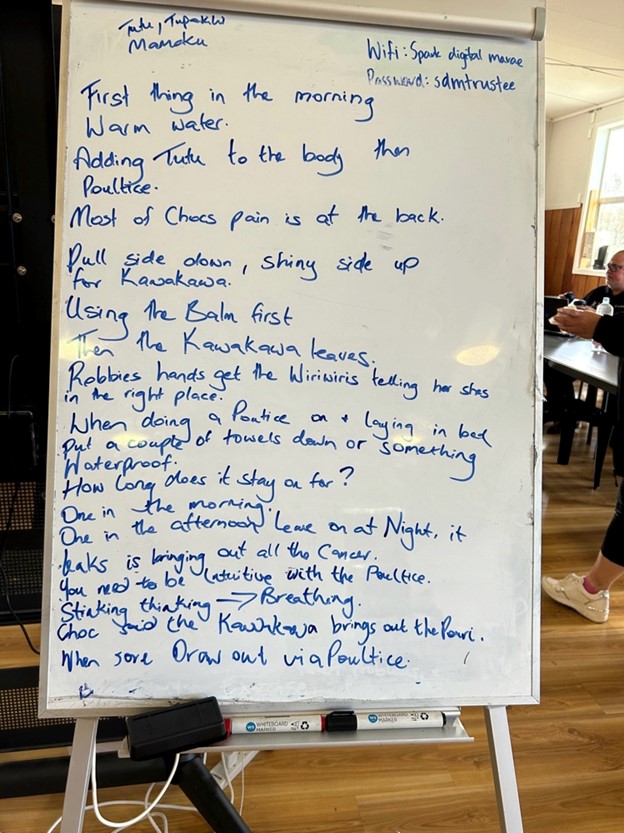
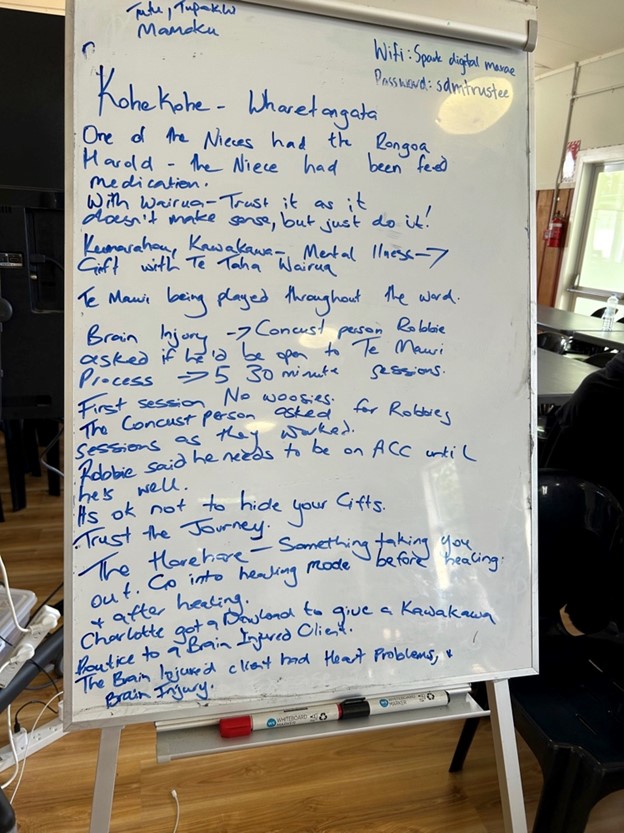
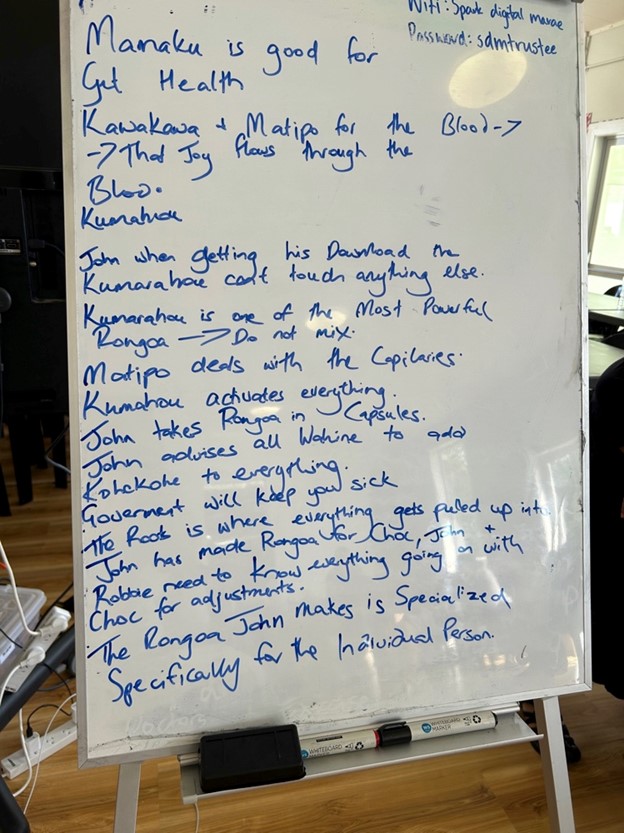
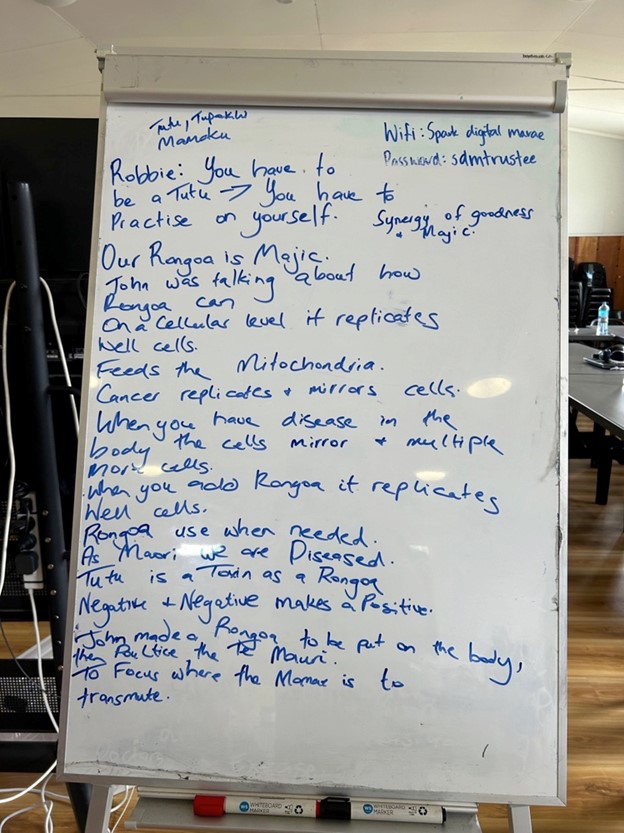
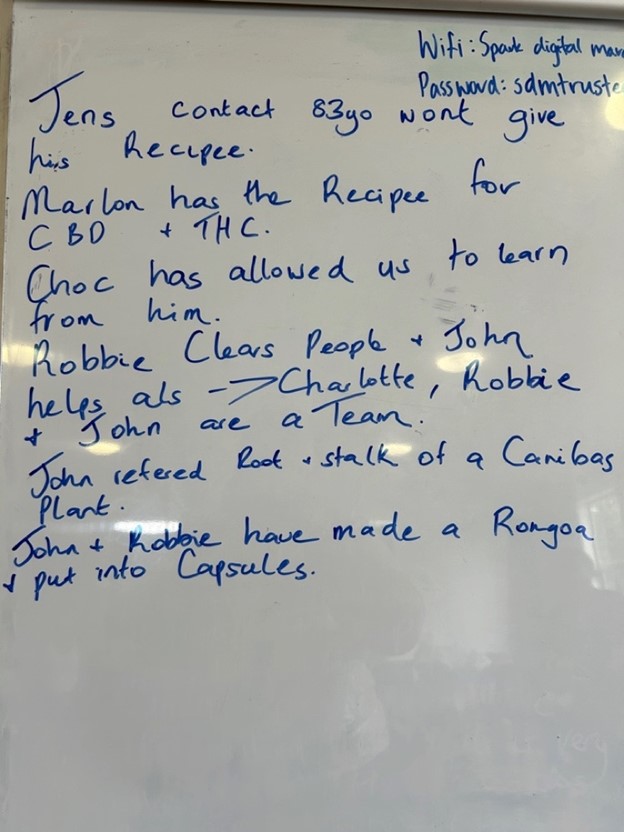
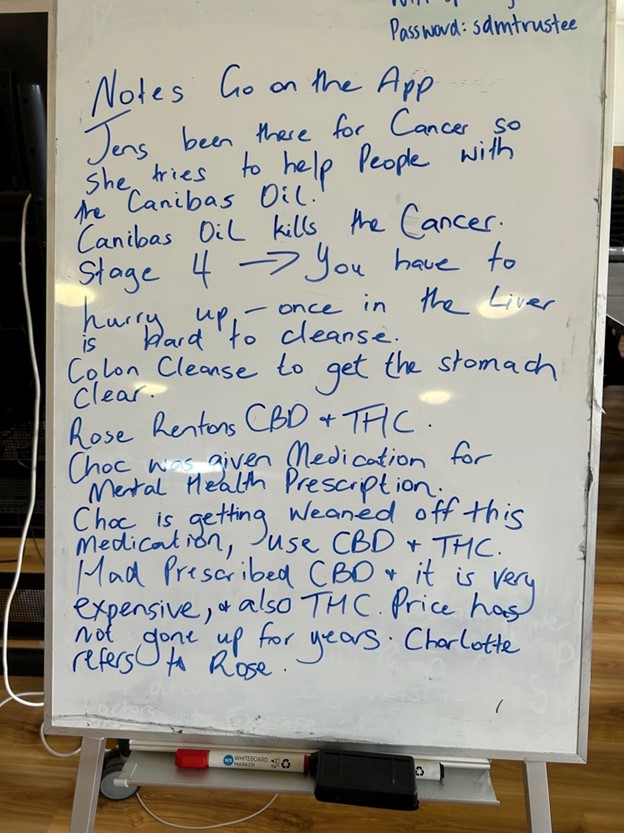
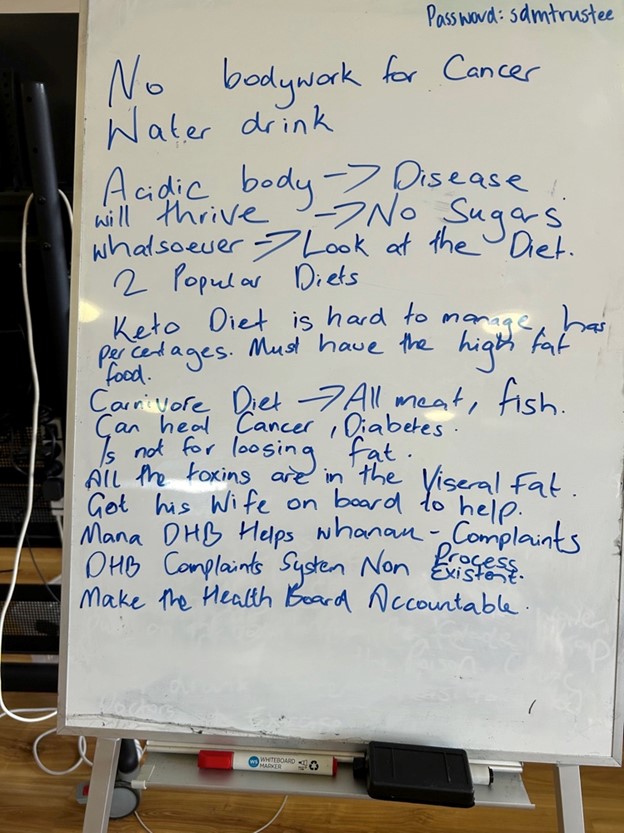
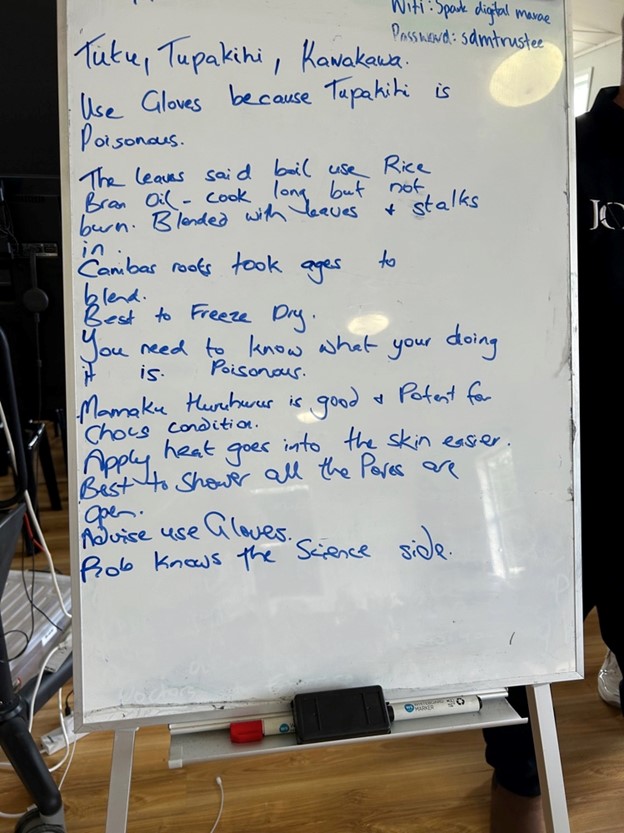
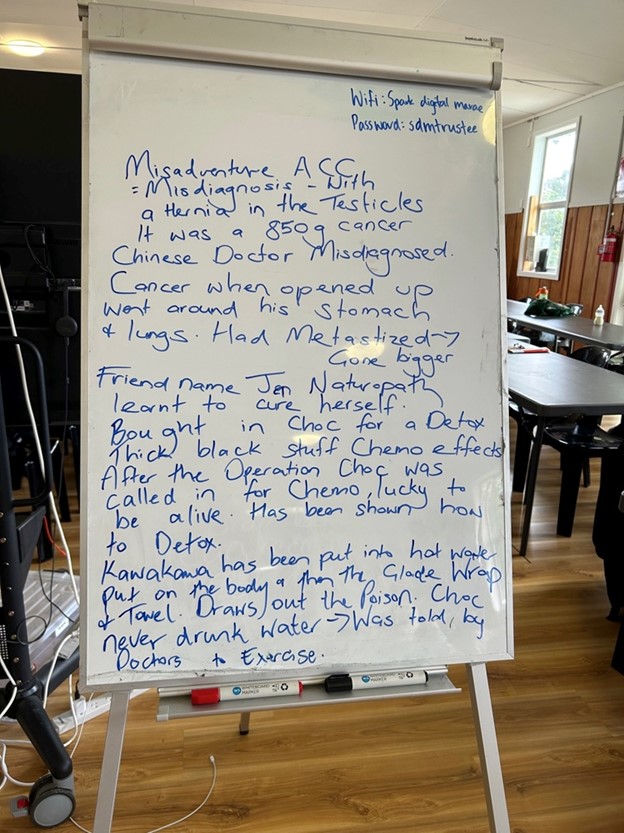
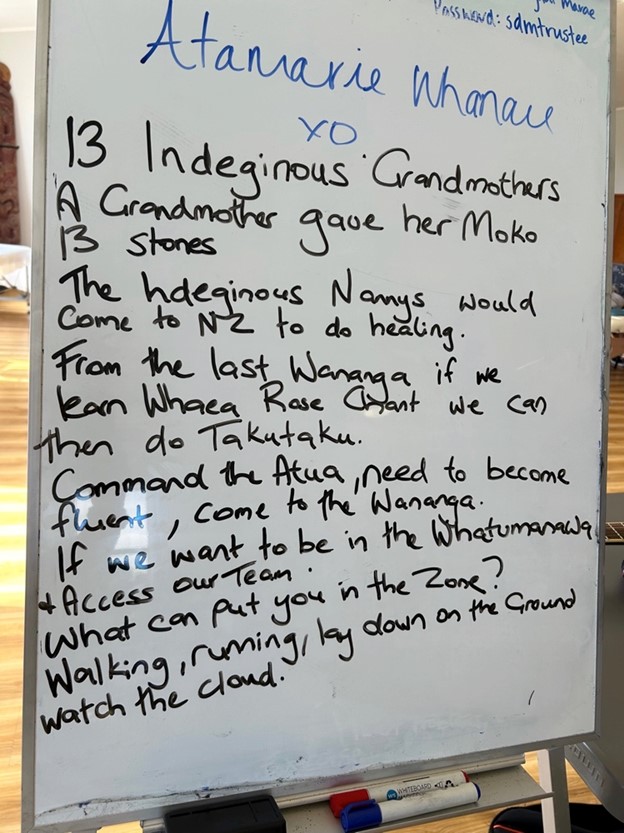
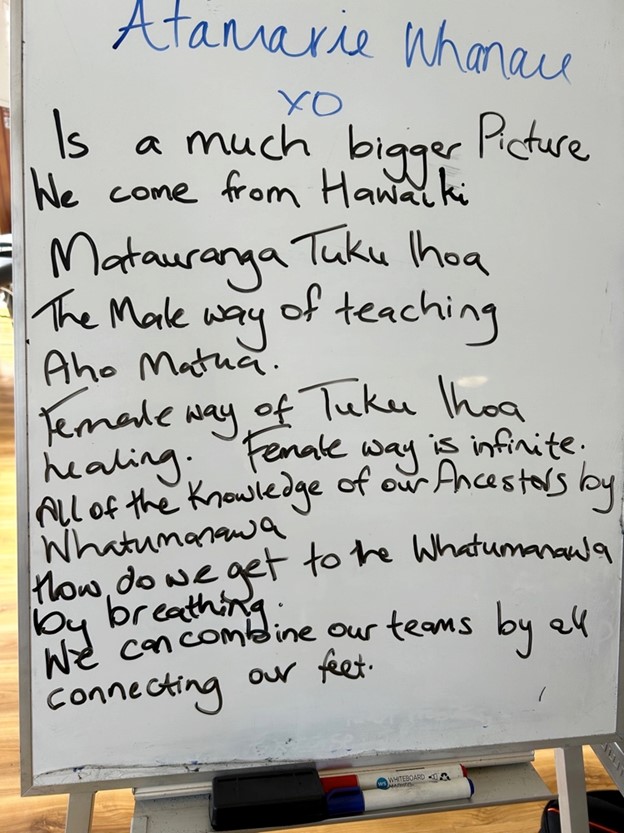
Western Health versus Traditional Māori Healing
© Copyright 2024. Dr Charlotte Mildon. Trust All Rights Reserved
Ngāti Kahungunu have the highest health and mental health statistics in New Zealand, and, we also have the third highest suicide statistics in the world. Western health is all about MEDS that only work with the symptoms but do not heal the disease DIS – EASE. The meds are like a plaster over the top. Nothing to do with healing. In the Western mental health system, whaiora who are assessed as medium to heavy are only given stronger and stronger MEDS that cause a dependence. These MEDS overload the liver and put stress on the other organs. Historically, traditional Māori healing romiromi and Rongoā, that heals our whanau, has not been allowed for our whanau in the hospitals, health clinics, psyche wards and mental health institutions. Yet health supplements are approved for whaiora but Rongoā is not. What’s wrong with that picture?
The healing lores of our Tohunga and Tohuna go way beyond the Western health practices that our people will rarely engage with and for good reason because it doesn’t work.
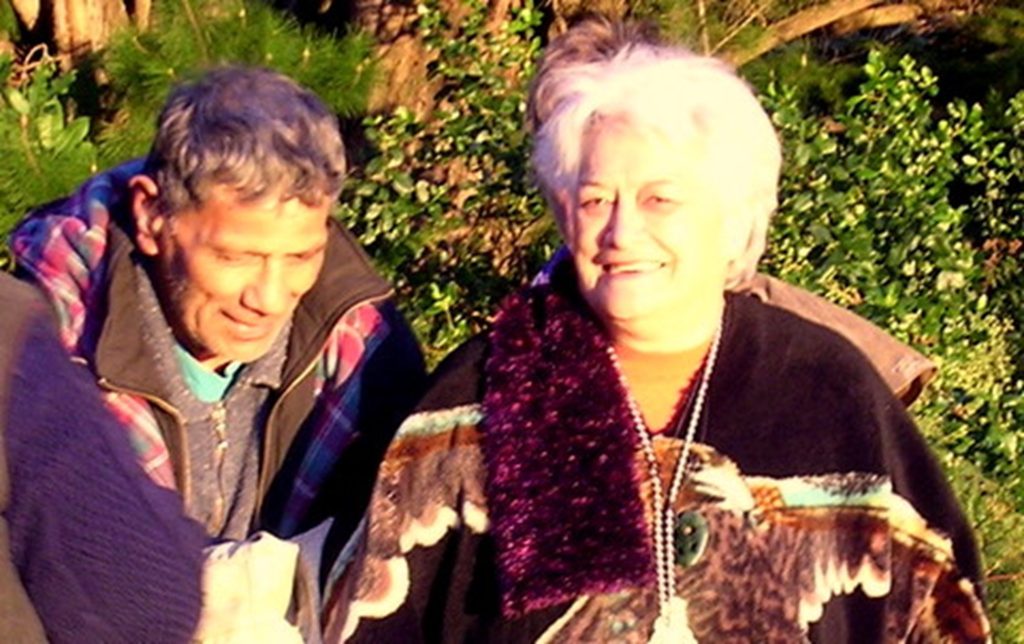
Master’s Thesis: the Essentialism of the Tohuna
It is in the sanctuary of mother nature that the whakapapa of Ngāti Hine-Manuhiri (my tribal ancestress) pulses in the veins of my father’s Tūhoe tribal ancestors; the descendants of the revered supernatural ancestress of the mist; Hine-pū-kohu-rangi. Her korowai (cloak) of mist stretches out over Haumapuhia (the beautiful spiritual phenomena) who dwells deep within the pristine waters of the lake. There is no beginning and no end, only a timeless illusion where one cannot tell where the water ends and the mist begins. Undaunted by these divine feminine beings, Tawhirmatea whirls in ecstasy around the invisible vapour of his twin flame Hine-pū-kohu-rangi, in anticipation of an awakening.
The return of our female Atua aligns with a holistic desire to raise healthy children who understand the mahi of the grandmothers who have a deep concern for our natural environment and can take the role of matriarchal leadership. My research was designed to create an awareness of the gender imbalance and the shift that is needed for a praxis of transformation for the emancipation of Māori women. Evans (1994) asserts that the female aspect exists in almost every aspect of our lives as women; the landscapes, the mountains, the seas, the stars, the moon, the darkness, the forest, the mist, the rainbows, all of whom are taniwha (supernatural phenomena) and tipua (supernatural phenomena) that we whakapapa to as Māori women.
The deficit of mātauranga-a-wāhine (Māori women’s knowledge) within the body of mātauranga Māori, demystifies the matriarchal leadership role of the Tohunga and the Tohuna for those who aspire to these feminine disciplines. My role is to inspire you to want to learn more so you can get a clearer understanding of mātauranga-a-wāhine (women’s knowledge) in traditional Maori healing with an understanding that the foundation of mātauranga-a-wāhine is the mother energy from ancient Hawaiki (the spiritual homeland of Māori), Hawaiki nui, Hawaiki roa, Hawaiki pamaomao.
Dr Pere calls the homeland, Hawaiki-tuawhakarere, a geographical place in history known as Lemuria. She identifies the time frame as being over 12,000 years ago when New Zealand was part of the largest continent in the world that extended out to the whole of the Pacific basin. The people of the MU are linked with the mother energies in Lemuria, an ancient civilisation otherwise known as the people of the MU. We are in the times of the prophecy of the return of the divine feminine in an awakening of the mother energies not only here but in indigenous cultures all around the world. The resurgence grandmothers joining together all around the world to heal our Atua wāhine Papatūānuku with all the universal mother energies has a clear focus on future generations of our grandchildren. There were 13 Indigenous grandmothers who came together from all around the world to ensure that the next 7 generations will care for mother earth and all her progeny. Aunty Pauline Tangiora, Tohunga kuia, cousin to Dr Rose Pere, bought these grandmothers to Gisborne as the ambassador of the 13 Indigenous grandmothers.

Pauline Tangiora
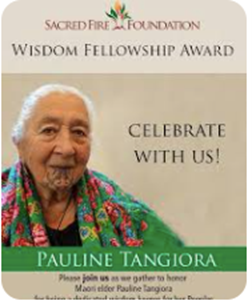
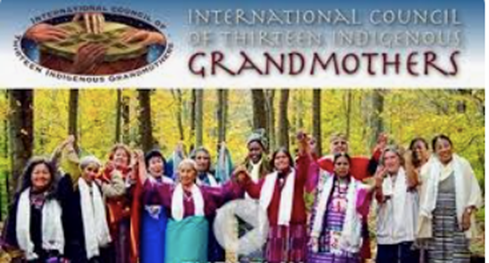
Their philosophy as medicine women was to focus on your own healing so the energy will ripple out to your whanau and your environment because ‘nothing will change until we change!’
The Tohuna and the Tohunga wāhine are relatively non-existent in all academic literature. Our kuia and koroua have long been highly respected as the cultural experts of Māori healing knowledge, more especially, the matriarchal leadership of the kuia.
Access to mātauranga tuku iho, nga puna mātauranga a kui ma a koro ma has only being reserved to expert Tohunga and Tohuna, where the knowledge had been passed down through the generations. This mātauranga is a result of many layers of whakapapa from our elder’s tribal teachings, both male and female, not just male, and it has been weaved into the knowledge of the wisdom keepers over many generations, going right back to mai rano.
According to Dr Pere, the ancient teachings of the Tohuna also describe Māori as the descendants of Ngāti Ra, the tribe of the central Sun, the Divine Spark, that links Māori with the ancient civilisation of Lemuria as the motherland from over 12, 000 years ago. The knowledge of Le Muria, from the tablets of Naacal in India which gave him the ancient stories of the motherland of Mu dating back 12,000 to 14,000 years ago.
An interesting theory that Levy (2007) was able to pinpoint, is the ‘lost civilisation’ from thousands of years ago through prior research that identifies the Polynesians as the descendants of Lemuria. The prophecy of Lemuria predicts an awakening of the female energies from the ‘lost civilisation’ of the people of the ‘MU as in LeMUria’
Another author Sheehan (2004), explains how the Māori were very closely connected with their cousins the Maoli in Hawaii in ‘an ancient civilisation’ known as the motherland of MU. There are many similarities in our languages, for example the almost identical pronunciation of the Māori and Maoli, and the words aroha and aloha (both meaning love), kia ora and kia ola (both being greetings) or romiromi (ancient healing modality) and lomilomi. There are many more likenesses from the Maoli to the Māori culture and yet Hawaii is practically on the other side of the world. Sheenan also identifies the kahuna (Hawaiian priests) from Hawaii as LeMUrian descendants, responsible for guarding the kura huna (the sacred wisdom from the mystery school) and practising the healing vibrations of love.
Unconditional Love, this is the most powerful energy that exists, and nothing can go past it ….because we have a direct link to our Divine Parents’ ‘The greatest power of all is ‘aroha’. Aro means Presence. Ha means Breath from our Divine Parents … Unconditional love comes from our Divine Source through our ‘Hearts’.…there are no limits (Pere, 2011).
The prophets and avatars of Lemuria are described by Sheenan as intuitively knowing that a flood was coming and therefore strategized to preserve ‘the ancient knowledge, raising the consciousness to the awakening of… absolute love’. Another korero by Joseph (2008) describes how the Lemurians were once whales in the sea that evolved over time into human beings. Interestingly enough, Sheehan (2004) explains in detail how the ancient Lemurian civilisation sank with the great flood, over ninety percent of the continent being submerged in water, all except for a place called Zealandia that apparently broke away from Australia and later resurfaced on its own. The sacred teachings of these ancient ones from Lemuria being strategically stored in the DNA cells of the human bodies and implanted into the quartz crystals of Lemuria.
An international shaman called Elizabeth Madaraz, who would come out to Rose Pere’s home in Tuai each year that I went out over a 17 year time frame, lived on a mountain in Auckland. When I went to her home for healing, she took me out to the mountain top to show me a huge quartz crystal rock that was imbedded in the entire side of the mountain. It was magnificent. I had never seen a crystal that size before. She took my hands and told me that we were once sisters in Lemuria. On many occasions we had met at the Māori New Year celebrations at Kopu Ariki and Dr Pere used to talk about using rainbow bridges for the spiritual ancestors to cross over from where they were to here. Elizabeth explained that the rainbow bridges came directly from this crystal on the mountain. Some of these quartz crystals in Aotearoa are locked within the confines of our beautiful mountains and covered over with vegetation. They are found in the healing retreats around New Zealand but no-one would ever know that they were there and they are not advertised or promoted by anyone and perhaps that is to keep them safe. The mātauranga is stored in the quartz crystals and in the DNA of our tamariki.
Only evolved beings hold the consciousness of Lemuria, the memory of which is stored in the DNA and cellular memory of the keepers of the secrets. Dr Pere explained how some Tohuna are aware of holding the secrets and share the consciousness of truth, love and wisdom while others are unconscious of it. Rose asserted that the ancient knowledge lies dormant for those who are unaware and await the divine awakening of the natural universe.
There is now a time and a place for the Tohuna to share what s/he can, to help those people who have forgotten how to stand in their own power and wisdom… to remember who they truly are…to link into the vibrations of a new age. It’s a matter of making sure that ‘Ngāti Ra’ the whole of humanity truly realize and remember from whence they came… The whole of the human family is called ‘Ngāti Ra’. We are all the living breath of the Central Sun, the Divine Spark. We all link into the ONENESS of all that is (Pere, 2011).
The role of the Tohunga has been deemed gender specific to men as have the roles of the Atua Māori. The effect this may have on the education of mokopuna is vital to our parents for unknowingly, the curriculum content for Māori in Early Childhood Education (ECE), interprets male specific mythology with abusive undertones to women, kuia and young girls.
My research design theorized that the loss of Māori women’s spiritual knowledge can be attributed to a number of causes and only a shared commitment to the holistic education of mokopuna Māori can heal the generational pain of colonization. It reflects an understanding of the spiritual leaders in our communities and exposes an invisible culture that is evident in ‘our attitudes, values, beliefs and assumptions’ in the 21st century (Magee, 2011. p.6).
We live in the ‘pulse of ancient Hawaiki’, which is known as New Zealand today. We link into the ‘Source’, a very powerful wonderful energy, an energy that unites us together as one. I come from a line of wisdom keepers…. from over 2220 generations. We come from unconditional love, that is what we come from, that is the Source of our being (R, Pere, 2011)
Pineaha Murray, a Ratana minister of Ngāti Kuri descent, described Moehau as one of the most powerful tohunga kuia (elderly woman) in the herstory of Te Tai Tokerau. According to Uncle Pineaha, feeding the babies was shared amongst the mothers when he was little so he didn’t always k now who was feeding him when he was a baby. His elders told him that in the old days, times were tough for food sometimes, so when the mothers ran out of breast milk, Moehau, the great tohunga of the sea would call out to the whales to beach themselves. Once they had milked the whales then Moehau would cause the water to come and take the whales back out to sea. Moehau was known as a Goddess of the ocean who had spiritual powers to beckon the whales and the sharks to come to shore whenever she called them (Murray, Ngāti Kuri. 2012).
Papa Nau Epiha, a Ngaapuhi elder from Matauri Bay, explains the powers of the karanga from Te Po (potential darkness) to Te Ao Marama (the world of light) within the whare tangata (the womb) (Te Raumiro Epiha nee Rakete as told by Nau Epiha documented by H. Hammond. Unpublished paper. 2000). He relates the five sacred karanga that his mother Te Raumiro explains as being pertinent to the whare tangata of the woman;
‘For wāhine, through life in Te Ao Marama, there are five karanga or tangi of this type that occurs:
- The first karanga of the wāhine is when she has her first period…to begin the sacred journey of pro-creation …with the stripping away of the uterus walls … the toto (blood) that would have sustained that potential life (of) … the kakano (seed).
- The second karanga or tangi of a wāhine is when she has her first intercourse and this moment is when the kūaha (door) of the whare rongo is broken and the whare tangata prepares itself for potential new life.
- The third karanga or tangi of a wāhine is when she has her first baby. New life has been created and nurtured within the whare tangata and the karanga comes at the moment the babies’ head enters Te Ao Marama (the world of light).
- The fourth karanga or tangi of the wāhine is her first call onto the marae … to her Turangawaewae (place of belonging through genealogical links) … the beginning stages of the powhiri as the re-enactment of the … spiritual wananga (of) IO… (in this context) the creation of the whare tangata (the universe in miniature)…and the wharetūpuna (a visible depiction of the universe in miniature).
- The fifth karanga or tangi of the wāhine is during the last struggle to breathe … as life departs the body and Papatūānuku beckons you back to the whenua (earth) from where you first came.
All these karanga/tangi belong to wāhine and they are all from Papatūānuku, all from the creation of Te Ninihi Pāraharaha’ (the full name of the womb in te reo Māori) (Te Raumiro Epiha nee Rakete as told by Nau Epiha and documented by H. Hammond. Unpublished paper. 2000).
Tenei Au
The karakia Tenei Au describes this journey of spiritual enlightenment. Papa Nau Epiha, relates his mother’s translation (Te Raumiro Epiha) of this karakia;
This karakia is more for wāhine than anyone else. When we look at the last part of this karakia (portioned out and planted into mother earth, the life principle of human beings comes forth in to the dawn). It’s talking about the birth of a human being. When the translation talks about the kete of knowledge, it’s talking about the three dimensions of the tangata, the physical, the mental and the spiritual, and when these are planted with the essence of Papatūānku and Ranginui, this is what is created. A perfect little baby that has everything it needs to survive and carry on the next generation (Te Raumiro Epiha nee Rakete as told by Nau Epiha documented by H. Hammond. Unpublished paper. 2000).
The emphasis on this metaphysical pūrakau is to achieve a spiritual state of enlightenment through an understanding of the spiritual, physical and metaphysical self.
Te Kaitiakitanga o mātauranga-a-wāhine
Papa Hohepa Delamere further describes Ruahine (also known as Rauhine) as the Goddess of Romiromi (an ancient Māori healing concept) who guided Tangaroa in the separation of the land from the waters thus the separation of Tangaroa from Papatūānuku (2003). He clearly disassociated Ruahine from the brothers or sisters of Papatūānuku and Ranginui and instead identified Ruahine as being an ancient being from a much higher order. According to Papa De La Mere, Ruahine was an even higher class than the Mareikura with a direct link with IO Agape which he defined as being much more than love. In support of this definition, Dr Pere also associates the mother energy with unconditional love (Raua, 2001). In support of this, Tau describes a pūrākau of Tangaroa being the first husband of Papatūānuku, not her son and this further endorses the concept of the foundational mother energies (2003).
Acknowledging both the male and female is vital for healing. For example, the words tamawāhine and tamatane are used to describe the male and female sides of the body and are an important acknowledgement of who we are in a holistic sense with links to our spiritual and physical wellbeing. Dr Pere identifies Tūmatauenga as governing the left side of the brain which in turn rules the male side of the body ‘te taha tāne’ or ‘tamatane’ (R. Pere. 2006). The twin flame of Tūmatauenga is Rongo (female Atua) who resides in the right side of the brain then oversees the left side of the body ‘te taha wāhine’ or as Dr Pere translates as ‘tamawāhine’ (R. Pere. 2012);
We (Māori) are whole brain learners, who have a perfect balance between the left and right brain … and when we have the whole brain working, it means we can link into the super-consciousness. Tumatauenga the Left Brain focuses on sequential, logical, rational learning, while Rongo his sister, the Right Brain, focuses on creative, intuitive learning, enabling a person to tune in with the universal mind, the macro. We don’t talk about it… it’s a part of us, it’s just natural. How does it manifest? For example, I can sit down, compose a song, write the lyrics and get the tune as well – straight off. That means the whole brain is doing its job (Pere, 2011).
Once again, this is a very unique way of seeing the body in its divine form as well as its physical form, the two being interconnected through whakapapa (genealogy). Knowledge of this calibre is not being shared in the education curriculum because it is a spiritual concept that comes from the wisdom of our sacred grandmothers. It is distinctively the knowledge that stems from the ancient ones in the indigenous culture of Māori.
Another example, is where Dr Aroha Yates-Smith recalls a koroua who would not give her the pūrākau of Hinekorako (ancestral rainbow) the tipua (supernatural being) who lives in Te Reinga, as he did not know her and could not be certain that the information entrusted would be safe with someone of another iwi. The fact that Dr Yates-Smith was a scholar at the University of Waikato who had been researching the existence of the Atua wāhine from rohe to rohe was insignificant to him. Rather, his love for his tipua whaea (female supernatural being) was far more important. Aroha thus recognized that knowledge can only be shared when relationships are established to protect the knowledge from being misinterpreted (Yates-Smith, 1998).
Tama-te-ra; the Mother Energy
The word tama means boy unless it describes a daughter which is then termed tamahine or tamawāhine. The word tama is also used for a son and becomes tamatane. From this we see that the word ‘tama’ is not generically specific to a male. In addition to this, Dr Pere identifies the sun as ‘Ra’ as well as the ancient mother energy ‘Tama-te-ra’ (R. Pere. Personal communication. 2012). At the Māori New Year celebrations at Kōpū Ariki, we would take part in the acknowledgement of the sun rising. Dr Pere would call out to Hine-nui-te-ra and tell us all that we were descendants of Ngāti Ra, the central sun the divine spark (R. Pere. Personal communication. 2005). To make sense of this, I considered that if the sun were a male element then perhaps it would be more suitably called Tāne-nui-te-ra which more aptly describes the great man of the sun.
Ngā Tupuna Whaea
Rikoriko
The whakapapa of the late Te Awhina Riwaka, a tohunga Rongoa (a priest and expert in Māori medicine) from Wellington and the late Hohepa De La Mere, a tohunga ahurewa (a priest/ess of a higher order), gives yet another rendition of whakapapa. It clearly identifies the primeval mother who according to the Te Awhina Riwaka (see Appendix 1), resided in the upper echelon with IO, the Great Spirit (T. Riwaka. Personal Communication. 2009). Papa Anaru of Ngāti Maui, identified Rikoriko in the opening of his whaikorero (formal speech) in Gisborne, a korero (speech) that is very rare in this day and age, indicative of a knowledge base that is steeped in the ancient teachings of the tohunga (A. Kupenga. 2012).
IO MATUA TE KORE = WHAEA RIKORIKO
IO Pae
IO Taha
Te Kore – tuatahi
Te Kore – tuarea
Te Kore – tuahotu
Te Kore – tuauenuku
Te Kore – tuakore
Te Kore – tuatamatea
Te Kore – tuanana
Te Kore – tuakaiariki
Te Kore – tuahuna
Te Kore – tuangahuru
(12 children)
The 23 descendants of Te Po The 23 descendants of Te Ao
Papatūānuku = Ranginui
The whakapapa shows an undeniable synchronicity of the male and the female elements from IO and Rikoriko right through to Papatūānuku and Ranginui (Sky father). Although the 23 descendants of Te Po and Te Ao are purposely not named here, they do in fact correspond with one another all the way through to Papatūānuku and Ranginui. It does however validate the existence of the Atua wāhine beyond Te kore as illustrated here with the female whakapapa of Te Po right through to Papatūānuku. Nowadays, the darkness of Te Po is associated with evil and depicts an underground like the Christian version of hell and Satan the Devil (the evil angel). Dr Pere deems these concepts to be foreign to Māori.
© Copyright 2024. Dr Charlotte Mildon. All Rights Reserved.
